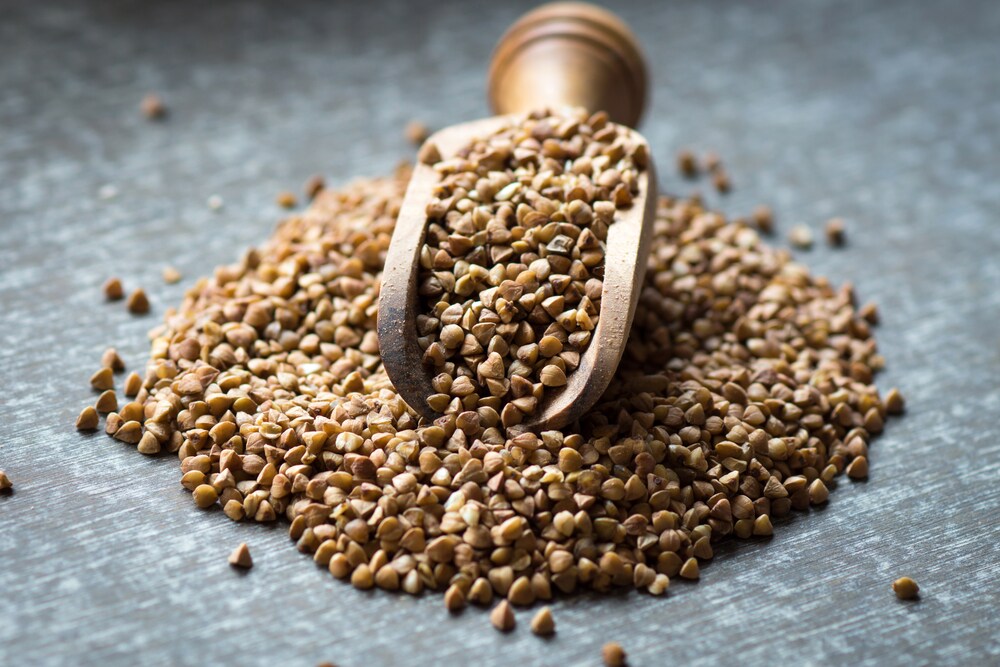 Boasting numerous impressive health benefits and grain-like similarities, buckwheat (Fagopyrum esculentum), is not a grain or related to wheat as its name implies. It is actually a fruit seed. Despite being hardy and easy to grow, one risk with growing buckwheat is contamination with stramonium (Datura stramonium). This member of the nightshade family grows wild throughout North America and has also spread to other regions. Stramonium can contain toxic concentrations of tropane alkaloids including atropine and scopolamine. These compounds then pass to foods and animal feed posing a risk to human and animal health.
Boasting numerous impressive health benefits and grain-like similarities, buckwheat (Fagopyrum esculentum), is not a grain or related to wheat as its name implies. It is actually a fruit seed. Despite being hardy and easy to grow, one risk with growing buckwheat is contamination with stramonium (Datura stramonium). This member of the nightshade family grows wild throughout North America and has also spread to other regions. Stramonium can contain toxic concentrations of tropane alkaloids including atropine and scopolamine. These compounds then pass to foods and animal feed posing a risk to human and animal health.
Using a modified QuEChERS (Quick, Easy, Cheap, Effective, Rugged and Safe) strategy, Chen et al. developed a method to determine the amounts of atropine and scopolamine in buckwheat.1 Eight samples used for this investigation came from local supermarkets located in Almería (Spain). Samples included: buckwheat, buckwheat flour and buckwheat pasta (Fagopyrum esculentum). Although this investigation primarily targeted buckwheat, for comparison purposes, they also analyzed samples of soy (Glycine max), wheat (Triticum aestivum), amaranthus grain (Amaranthus caudatus), chia seeds (Salvia hispanica) and peeled millet (Panicum miliaceum).
Chen and colleagues ground samples into a powder for analysis. They also prepared reference samples of atropine and scopolamine and optimized the chromatographic conditions using calibration curves at 0.1, 0.5, 1, 2.5, 5, 10, 25, 50 and 100 µg/L prior to analyzing real samples. To maximize yield, the team investigated using dispersive solid-phase extraction (d-SPE) as a clean-up step, using graphitized black carbon (GBC), primary secondary amine (PSA), Z-Sep+ and florisil. For this, they diluted extracts with water (50:50, v/v) prior to chromatographic analysis.
After testing, they found that Z-Sep+ and florisil resulted in low yields. With PSA (50 mg), the researchers achieved yields of 84% to 86% for atropine and scopolamine. Likewise, they achieved recoveries of both compounds in the range of 76–77% using GBC (50 mg) as a sorbent. Further optimizations determined a combination of PSA (25 mg) and GBC (25 mg) was the best choice with yields scopolamine and atropine reaching 76 ± 4% and 83 ± 5% (n = 3), respectively.
Initially, the team used an HPLC method to detect atropine and scopolamine. Since alkaloids are subject to transformations in the metabolism and the environment, the team turned to Orbitrap mass spectrometry to detect 23 atropine and scopolamine transformation products. For this, the team used a Transcend high-performance liquid chromatography (HPLC) instrument coupled to an Exactive mass spectrometer (Thermo Scientific) with a heated electrospray ionization source (HESI–II). They also used Xcalibur version 2.2.1 with Qualbrowser to process data (all from Therm Scientific).
The authors report that they did not detect atropine and scopolamine compounds in the eight samples analyzed. They did, however, detect three scopolamine transformation products, including norscopine in amaranthus, and hydroscopolamine and dihydroxyscopolamine detected in chia. All compounds had a mass error lower than 5 ppm. The authors point out that despite not detecting the parent compounds in these samples, they could theoretically be present under different conditions. As such, the authors recommend further analytical tests to confirm these compounds and if detected, these compound should be subject to routine monitoring.
Reference
1. Hongping, Chen, et al. (2017) Simultaneous determination of atropine and scopolamine in buckwheat and related products using modified QuEChERS and liquid chromatography tandem mass spectrometry Food Chemistry 218 (2017) (pp. 173–180)






Leave a Reply